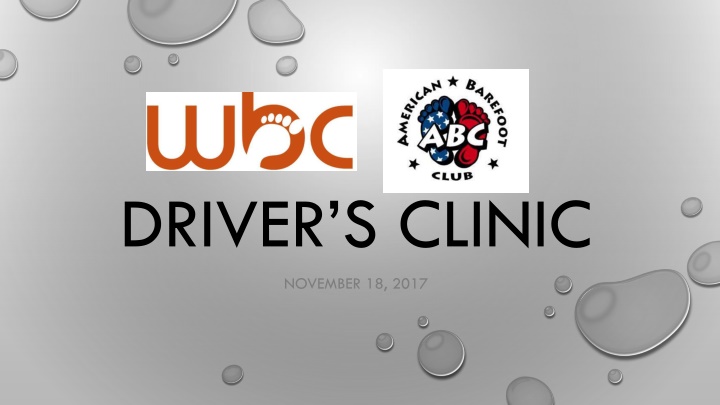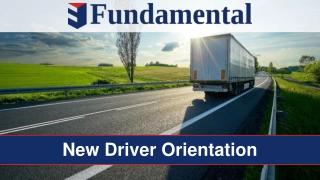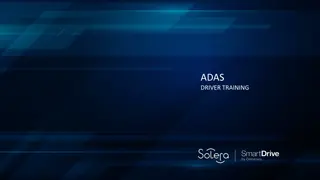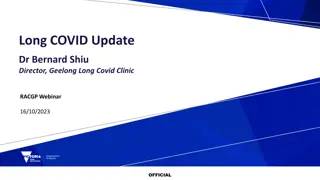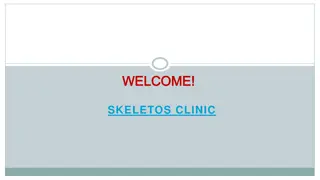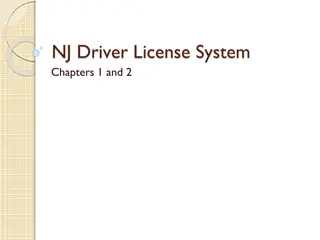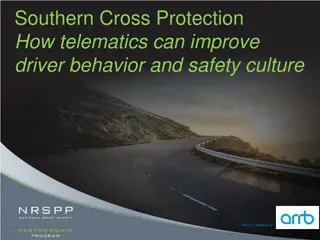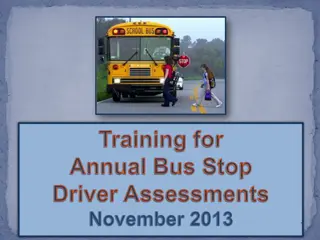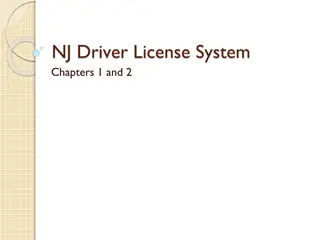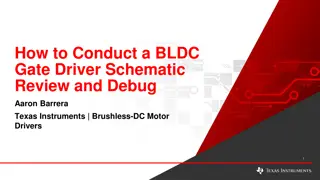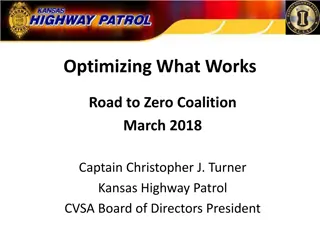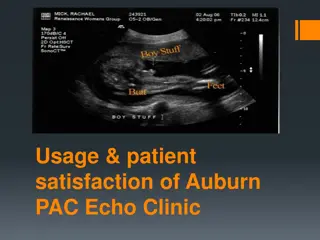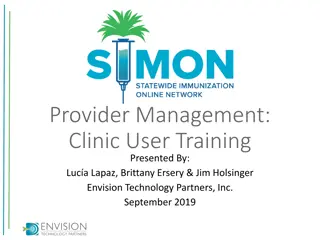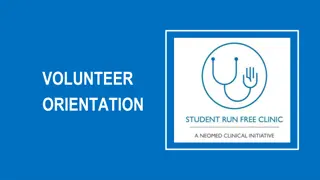Driver's Clinic Overview and Guidelines
This content provides detailed information on topics covered in a driver's clinic, including definitions, speed requirements, speed tolerance, disqualification criteria, and event management tips. It emphasizes the importance of understanding basic rules, maintaining specific speeds, and following safety protocols to ensure a successful and fair competition. The clinic agenda covers essential aspects for chief drivers to excel in their roles, such as checklist items, question assignments, and course specifics. Overall, the document serves as a comprehensive guide for drivers participating in the event.
Download Presentation

Please find below an Image/Link to download the presentation.
The content on the website is provided AS IS for your information and personal use only. It may not be sold, licensed, or shared on other websites without obtaining consent from the author.If you encounter any issues during the download, it is possible that the publisher has removed the file from their server.
You are allowed to download the files provided on this website for personal or commercial use, subject to the condition that they are used lawfully. All files are the property of their respective owners.
The content on the website is provided AS IS for your information and personal use only. It may not be sold, licensed, or shared on other websites without obtaining consent from the author.
E N D
Presentation Transcript
DRIVERS CLINIC NOVEMBER 18, 2017
AGENDA Definitions Know the basics! Learn the Rules Chief Driver s Checklist Questions Assignment
DEFINITIONS IT S TIME TO LEARN THE BASICS!
SPEED The Driver must attempt to drive to the exact requested speed and never intentionally use the speed tolerance. Course Speed The Skiers requested speed through the course, +/- the tolerance for the event. Start Speed The Skiers requested speed for the start portion of the pass, +/- the tolerance for the event. Planing Speed/RPMTheSkier s requested speed/RPM for planing during the second phase of acceleration up to start or course speed, +/- the tolerance for this phase. Skiers are not allowed to request speeds in terms other than whole KPH, one half MPH or maximum speed in the jump event. The driver is required to attempt to drive to that exact speed. The driver should never intentionally drive a hot or slow speed.
SPEED TOLERANCE Jump Speed Tolerance. +/- 1mph/1.5kph Trick and Slalom Tolerance. +/-1/2mph/1kph Planing Speed/RPM Tolerance. +/-3 mph/5 kph/200 rpm. Note: Speed Greater Than 72 kph/44.7 mph. Failure to attain speeds greater than 72 kpm/44.7 mph shall not be grounds for a re-ride [1007(E)]. Equalization Pass: Equalization passes are taken with the approval of the Chief Judge whenever the boat crew has exceeded the turnaround time by a margin that allows conditions to become substantially different to the other competitors in the event. Leveling Pass: Leveling passes are taken before every event. During this pass the boat crew distribute themselves to produce the optimum wake. Top speed, 15 second timer, and all speed measuring devices should also be checked during this pass. Leveling and equalization passes are the biggest single waste of time traps that most drivers fall into. The driver should have a clear directive from the ACJ or CJ regarding equalization passes due to long turnaround times. Do not let the boat judges bully you into taking unnecessary equalization passes. Most dry passes past the jump are a waste of time. Discuss the plan before the event with the lead officials.
DISQUALIFICATION Safety Compliance. Failure of a skier to wear a wet suit or helmet when required shall be cause of immediate disqualification from the event by the Safety Director. Danger to Himself. No skier shall be allowed to compete or continue to compete if, in the opinion of the Chief Judge, Safety Director and a majority of the Event Judges, his competing would be a danger to himself or to other skiers in the tournament. Whenever practical the advice of a doctor shall be obtained. Unsportsmanlike Conduct. A skier shall be disqualified by a majority vote of the Appointed Officials due to actions of the skier, parent, spouse or representative who may be charged with unsportsmanlike conduct because of extended or unwarranted harassment of an official or other competitor on behalf of the skier. Detrimental to the Sport. A skier may be disqualified by a majority vote of the Appointed Officials due to actions considered detrimental to the Organizers or actions considered detrimental to the sport of barefoot water skiing. Not Ready at Starting Dock. Once the starting order is posted, it s the responsibility of the skier to be present at the starting dock in time for his turn. Any skier who fails to be on immediate hand and in condition to ski when the towboat is ready for him shall be disqualified from the event. Does Not Respond after 10-Second Call. The skier shall indicate his readiness to go after the 10-second call by the Event Judges. Where a skier fails to indicate his readiness to go by the expiry of the 10 seconds, the Communicator Judge shall call TIME and raise his hand to indicate the expiration of time. Should the skier not immediately signal the towboat to go via the Stop In Gear or OK command, the Communicator Judge shall advise the skier that he has been disqualified for that pass You may be called upon to vote on any of these Issues. Know all of the facts before your vote. Utmost care should be given that to ensure the skier fully understands or that the skier is not in some danger that has kept him from signaling for the boat to proceed.
REPLACING OFFICIALS The Chief Judge is permitted to replace Event Judges and Drivers during an event at his discretion. Such changeovers shall take place between groups. Skier divisions may be subdivided into groups so as to make each group 45 minutes to an hour per boat crew.
RL TOURNAMENTS (C) Rounds. (1) No more than four rounds per day are permitted in any one competition. (2) Ranking list rounds shall be declared before the start of the competition. THIS DOES NOT MEAN ONLY 4 ROUNDS ARE PERMITTED IN ANY COMPETITION BUT THAT ONLY 4 ROUNDS OF RL ARE ALLOWED PER DAY. FOR MULTI-DAY TOURNAMENTS, 4 RL ARE PERMITTED AND MUST BE DECLARED EACH DAY.
COMMANDS Terminology When preparing to start from rest, the skier shall communicate with the towboat only with the words IN GEAR, OK, or STOP. The towboat shall only proceed on the OK command. Note: No re-rides will be given due to departure from the standard terminology as outlined in [1007(B)]. For safety purposes and to ensure proper communication with the towboat, the STOP command can be communicated to the towboat crew by raising one hand, thus visually as well as verbally communicating the command to the towboat crew. Start of Pass A skier is considered to have started the pass once he gives the OK command to the towboat crew. It is always better to err on the conservative side and not proceed when you are unsure of the command. For safety reasons, Drivers should avoid starting a pass on commands such as Ready , Gitty Up , Go , etc. If a skier gives the In Gear command followed by any command other than Stop or OK the towboat should remain in gear and at idle.
JUMP EVENT 302(D) Jump Speed 1) Course Speed. The speed through the jump course shall be requested by the skier in units of 1 kph/1/2 mph or the maximum speed of 72 kph/44.7 mph. 2) Speed Obtained. That course speed shall be obtained not later than when the towboat reaches the jump course entry gates. Note: A mandatory re-ride is required if the towboat speed through the jump course is judged to have exceeded 73.5 kph/45.7 mph through the course while the skier is in possession of the handle [1003], and prior to BSP being recognized after the jump.
SPEED NOTIFICATION On achieving course speed, the driver shall notify the towboat Judge(s) by calling speed. The driver must announce when they have achieved the requested speed so the judges can be aware if they are before or past the course buoys where the speed is required to have been achieved.
SLALOM & TRICK EVENT Rates of acceleration: The requested rates of acceleration in the terms slow, medium or fast, for the three phases: pull out of the water or off the dock, tower, or dry land; ride over the bumps; and acceleration to speed. Important Considerations: 1) The rate of acceleration is NOT a speed. It is the rate at which the throttle is advanced to the requested speed. If the skier does not ask for a planing speed the driver must continue to smoothly advance the throttle according to the skier s instructions. 2) Too many drivers watch the skier in the mirror and make decisions for the skier. A call for a medium acceleration means the driver will push the accelerator at a medium rate and keep accelerating until requested speed has been reached. 3) After the boat starts accelerating the driver should only be looking at the tach, speedo and course line and should only move from one acceleration phase to the next when instructed to do so by the communicator judge. 4) The communicator judge should be in eye contact with the skier when the instructions are given. While still maintaining eye contact the instructions should be read back to the skier in a loud, clear voice so all the boat judges and the driver can hear them. 5) If the skier gives commands that are unacceptable, e.g. a fast-medium out of the hole The communicator judge needs to determine if the skier wants a medium or a fast acceleration out of the hole. This will require you to tell the skier you cannot accept any instructions but slow, medium or fast and to please tell you in one word which acceleration he prefers for that phase.
PATH During the pass the towboat shall follow a straight path, approximately down the center of the course while the skier is in possession of the handle or until the shutdown buoy is reached Occasionally, you will end up on a course that Is not right down the middle or is aimed someplace other than the end of course. Sometimes you can fix It sometimes you just have to admit a mistake and shut the boat down and request the event judges to consider offering a re-ride.
ENGINE TRIM POSITION The skier can request the driver to change the engine trim position from the default position and is responsible to approve its placement before commencing, i.e: No re-ride shall be given due to incorrect engine position after the skier has adjusted the trim from the default position [1007(L)]. NOTE: The skier has the option to ask for the engine to be trimmed before the start or after the start whilst the boat is accelerating to speed. The skier may instruct the driver to trim to a desired speed or to trim to a desired position. Unless the driver does not change the trim from the default position after the skier requests the trim change this shall never be a cause for re-ride. The skier must request and approve the change of trim before the start. For example, a skier may request "Get to full speed and then trim it up until we reach 72. Or, "after my start I want you to hit the trim button 3 times very quickly."
PASSES - JUMPS Exceptional Circumstances: In exceptional circumstances the Chief Judge and the Appointed Officials are authorized to vote to reduce the number of jumps for a round to a minimum of two, and post a notification before the start of the round affected. Skier Loses Helmet: If a skier loses his helmet during the start or before reaching the jump ramp, the towboat shall immediately stop unless it s unsafe to do so. Should it be unsafe for the towboat to stop, the skier shall ski past the jump whenever possible, and this jump shall be scored as a fall. These are not grounds for disqualification from the remainder of the event. This situation requires your utmost diligence for safety. If you feel you can stop the towboat without endangering the skier on the jump do so. But If slowing the boat down would become a hazard then you have to maintain a steady speed past the ramp. If a skier loses his helmet after the OK command is given the jump will be scored as a fall.
JUMP OFFICIALS Judges Boat Judge: One Event Judge shall ride in the towboat to observe towboat path, course speed, the skier s performance in relation to maintaining BSP from start-of-course buoy, over the ramp, and regaining BSP after the landing before the end-of-course buoy, and Driver s compliance with the skier s instructions. Agreement: By observing the speed measuring devices the Driver and Boat Judge shall both agree that the skier received their requested speed through the course. Speed Adjudicator Where a speed control system is not used, a Speed Adjudicator shall ride in the towboat to verify the boat speed via GPS. In the event of a disagreement between the Driver and Boat Judge, the speed recorded on the Speed Adjudicator s GPS shall be used.
DOCK, TOWER, OR LAND START (FLYER) Dock, Tower, or Dry-Land Start (Flyer) A dock, tower, or dry-land start (flyer) shall only be permitted on the first pass. Towboat Action Remain at Starting Dock. The towboat shall remain at the starting dock until the 10-second call. At the 10-second call from the Boat Official, the towboat shall go into and remain in gear at idle or at requested speed until the OK or STOP command is received from the skier. (Note: Under no circumstances is the towboat to accelerate away without having received a clear audible OK command from the skier. It is better to give a re-ride for a misunderstanding than risk injury to a skier.) Whilst this rule requires the boat to remain at the dock until the 10-second call, it does not require that the boat remain sideways to the course. If it is impossible for the boat to be positioned in line with the course while waiting for the 10-second call, it is recommended that at the 30-second call the boat shift position so it is facing away from the dock whilst still remaining as close to the dock as safety allows.
CHIEF JUDGE DECISION Chief Judge Authority After the Chief Judge has been made aware of all the facts pertaining to a decision made by any official, the Chief Judge may then overrule that decision to ensure compliance with all rules. This overrule is not limited to protests and applies to any decision that in the opinion of the Chief Judge is not in compliance with the rules. Use of Evidence The Chief Judge is free to use any and all evidence he feels appropriate to effect an expeditious and correct decision.
REVERSE CHIEF JUDGE DECISION Any decision taken by the Chief Judge to overrule any official(s) in accordance with 903 may be reversed providing all of the following requirements have been met: Filing: The written reversal protest shall be filed within 30 minutes after event has concluded or 30 minutes after the Chief Judges decision to overrule any official(s) have been posted, whichever is later. Content of Written Protest: The reversal protest shall contain the rule number(s) that the Chief Judge has violated. Decision: The Chief Judge shall as soon as practical, present the reversal protest to all Appointed Officials, the Chief Judge shall make the Appointed Officials cognizant of the facts when presenting the protest to them for consideration, i.e. present his overrule decision with the rule numbers cited and the reversal protest with the rule numbers cited. Two-Thirds: Two-thirds of all Appointed Officials are required to vote in favor to reverse the Chief Judge s decision to overrule any official(s). Decision Posting:Any vote that reverses the Chief Judge s decision to overrule any official(s) shall be posted as soon as possible. NOTE: You may be called upon to vote on a reversal protest. Refer to the rulebook after you have obtained all of the facts. Your role is to ensure compliance with the rules.
RE-RIDE REQUEST Initiated by Event Judge or Driver: Requests for re-rides shall be initiated by an Event Judge or Driver before the next skier starts and shall be decided as soon as practicable thereafter. The Video Operator is permitted to offer information that may have escaped the notice of the Event Judges. Skier or Team Representative: The Team Representative or skier is free to draw the attention of the Event Judges to some relevant condition or circumstance affecting the granting of a re-ride that may have escaped their notice. The Event Judges shall consider such submission and act on it or not as they see fit. The Event Judges shall maintain the strictest vigilance to ensure the interests of the skier are fully respected. If you see something like ducks or rollers on course, announce it to the judges as It Is happening. Keep a close eye on conditions and alert the judges if you think water conditions are changing substantially. Try to settle all re-ride and protest issues before they happen. If you made a mistake, admit it at that moment, don t wait for anybody else to mention it.
MAJORITY A re-ride shall be granted when a majority of the Event Judges agree that the skier is entitled to a re-ride. The driver may initiate re-ride discussions if they know they did not comply with skiers instructions, pulled a crooked path, or noticed conditions or events that the judges may have overlooked.
OPTIONAL RE-RIDE Conditions or Malfunctions: The skier shall be offered an optional re-ride only on the pass affected when water, weather or other conditions are substantially different from their competitor s conditions or in the event of a malfunction of the tournament-supplied equipment occurs that, in the opinion of the majority of the Event Judges, unfairly affects a skier. Skier Instructions: The skier shall be offered an optional re-ride, only on the pass affected, when the towboat crew failed to comply with the skier instructions given and speed tolerances in accordance with Chapter 3. Engine Trim Position: Skier shall be offered an optional re-ride only on the pass affected if the engine trim position was not at the default position prior to the pass as required by 1501(B). Towboat Path During the Jump Event: Skier shall be offered an optional re-ride only on the pass affected if the path of the towboat differ by more than one-half of the gate width from that requested by the skier. Re-ride for boat position, at the jump, is only possible if the skier has called close or wide. If the skier has called split as long as the boat remains within the course the boat can never be more than gate width away from the requested path unless it has left the jump course.
MANDATORY RE-RIDE Unfair Advantage: Skier shall have a mandatory re-ride when it s the opinion of the majority of the Event Judges that a malfunction or conditions gave the skier an unfair advantage on the pass affected. For example, a judge not hooking the main line to the leader for a skier in slalom. A short rope would be a definite advantage. The 5-minute rest period is available for mandatory re-rides. Start/End of Pass: Skier shall have a mandatory re-ride if the start or end of the pass cannot be determined by the combined use of the official video and the Event Judges sheets on the pass affected. Unfortunately, when this happens we have to use the same crew, which sometimes becomes difficult due to the officials working another event by the time we find out we are giving a re-ride for time. The situation is much easier to resolve quickly if the officials alert the Chief Scorer that they had a problem with time and it should be looked at immediately. Jump Event: Skier shall have a mandatory re-ride if the speed through the jump course is judged to have exceeded the maximum course speed of 73.5 kph/45.7 mph as checked by a GPS speed-measuring device while the skier is in possession of the handle and prior to BSP being recognized after the jump [405(D)].
RE-RIDES WHEN TAKEN Jump Event. Re-ride shall be taken: Immediately. If a single re-ride is granted for other than temporary incapacitation, that re-ride shall be taken immediately. Five-Minute Rest. If more than one re-ride is taken in any series, the skier shall have the option of a five-minute rest before recommencing his turn in accordance with 1205 (A). Note: You don t allow a five-minute rest for the first re-ride in a jump series. Slalom and Trick Event If a re-ride is granted for other than temporary incapacitation, that re-ride shall be taken either immediately or the skier may elect a five-minute rest period permitted in accordance with 1205(B). If the skier has elected the option of a five-minute rest period the next skier in order shall ski, and the re-ride shall be taken at the conclusion of the skier s turn during which the five-minute rest period expires. Note: Every re-ride in trick and slalom has the option of a five-minute rest period. If they choose to rest the tournament shall carry on with the next skier and the rest period is really as long as it takes to pull the next skier.
TEMPORARY INCAPACITATION If the skier should become temporarily incapacitated through no fault or action of his own, the skier shall be allowed time to recover until next round of competition of that event has started or it can be satisfied, where possible on medical advice, that he is sufficiently recovered to continue. In the meantime, the competition goes on with succeeding skiers. Temporary incapacitation results from no fault of the skier, e.g. the skier fell and was injured due to excessive speed, was pulled into very shallow water that resulted in a hard fall, pulled into an over hanging tree limb, etc.
RE-RIDE OPTIONS - TRICK Start Trick: In the event of a re-ride during the start trick portion of the pass, the skier shall have the option of: Repeat Start Trick Only. Repeating the start trick while retaining the pass tricks scored during the affected pass, or: Repeat Start and Trick Pass. The entire pass for which the re-ride is given shall be annulled and scoring for the re-ride shall comprise the start trick and the pass tricks made in the 15 seconds of the re-ride pass. Note: For a driver s error or some tournament equipment failure during the start phase of a trick pass not only can the skier choose to keep or repeat the start or to keep or repeat the pass tricks they also have the option of changing everything including doing a completely different start and different pass tricks. Pass Trick: In the event of a re-ride during the pass tricks portion of the pass: Annulled Pass: The 15-second pass score of the affected pass shall be annulled. Start Trick: Any start trick on the affected pass, whether successful or unsuccessful, shall stand and be carried forward as the start trick score for the re-ride of that pass. On the re-ride, the skier is permitted to attain BSP by any start trick listed in 604 that he chooses, but that start shall not count for scoring purposes. Scoring: Scoring for the re-ride shall comprise pass tricks made in the 15 seconds of the re-ride pass plus the start trick score carried forward from the affected pass.
NOT BASIS FOR A RE-RIDE Top Speed Advisory: Any top speed advisories given from the towboat during the competition shall be considered a courtesy and shall never be grounds for a re- ride or protest. Top speed advisories are a courtesy and approximate guesses to help a skier understand the capabilities of the boat. Standard Terminology: When preparing to start from rest, the skier shall communicate with the towboat only with the words IN GEAR, OK, or STOP. The towboat shall only proceed on the OK command. A misunderstanding due to a departure from this standard terminology shall never be grounds for a re-ride or protest. If you are not sure of a skiers command, do not go. Ask for clarification if you ever have a doubt about the readiness of the skier Before Turnaround Time: A skier going before the turnaround time has expired [1201(C)] shall never be grounds for a re-ride or protest. Rope Position: Incorrect rope attachment height [302(A)& 303(A)] shall never be grounds for a re-ride or protest. Boat Speed: The failure of the towboat to attain a speed greater than 72 kph/44.7 mph shall never be grounds for a re-ride or protest. Last Trick In Time: A mistake by the Event Judges communicating the last trick in time [714(D)] shall never be grounds for a re-ride or protest. Provisional Score: An error or misunderstanding on the part of the Officials in communicating provisional scores [1010] shall never be grounds for a re-ride or protest. Skier Lands Prior to or Past Landing Box: A successful jump that is unreadable due to the skier landing prior to or past the video box shall never be grounds for a re- ride or protest. Failure of Skier s Equipment: A failure of skier s own equipment shall never be grounds for a re-ride or protest. Skier s Equipment: Failure of a skier in the trick event to ensure their equipment is in the towboat for the second pass shall never be grounds for a re-ride. 30-Second Call: Failure of the event judges to give the 30-second call shall never be grounds for a re-ride. Engine Trim Position: If the skier requests the engine position to be changed, this shall never be grounds for a re-ride or protest.
REFUSAL TO ENTER COURSE A competitor is permitted, for reasons acceptable to the Event Judges, to refuse to enter the course in any event and shall do so by throwing the handle into the air. Note: Re-rides are only given in accordance with the conditions specified in 1003. There will be instances when the safest thing for a skier to do is refuse to enter the course. Floating objects, gusting winds, sun in the jump course, and equipment failure are among the reasons a skier may throw the handle. It is up to the judges to decide if the skier was justified in throwing the handle. You should REALLY weigh on the side of the skier if he tosses the handle prior to the course. A skier s safety of up utmost concern.
SAFETY OFFICER Safety Officer: A Safety officer who is familiar with all tournament events and practice and ideally is fully trained in First Aid, Emergency Resuscitation and Water Rescue Techniques shall be on-site at all times. Floated to Shore: Any skier that is unable to climb into a towboat unassisted shall be floated ashore and lifted from the water on a suitable board or stretcher. Into Towboat: Under no circumstances shall an injured skier be lifted passively over the side of a towboat. Life Jacket: A life jacket shall be in the towboat at all times; in the event of a serious Fall by the skier, a swimmer wearing a life jacket shall enter the water to assist the skier. NOTES: It is your responsibility to ensure that a life jacket is in the towboat at all times. In case of an injury, immediately contact the Safety Office and the Chief Judge. In addition, you should seek assistance from any medical personnel onsite.
TURNAROUND TIMES Set by Chief Judge: The Chief Judge will set the turnaround time after considering the recommendation of the Tournament Director and Chief Driver. NOTE: Go out and actually run the course with a stopwatch. Try it at several different time periods until you find the best option for the tournament. Responsibility of Driver: Turnaround times between passes is the responsibility of the Driver as follows: Time Commences: The time clock starts on whichever is later; the towboat or chase towboat coming off plane at the end of the course. Warning: The driver shall notify the Event Judges at 30 seconds and 10 seconds to the expiration of the turnaround time. Event Judges shall notify the skier at 30 second and 10-second to expiration of turnaround time. NOTE: You will be responsible for tracking turnaround times, 30-second calls and ten-second calls, injury time outs, equipment time outs, etc. You should bring at least one watch to the boat with you as well as a GPS. These are the tools of your trade.
EQUIPMENT FAILURE, ONE-MINUTE First Pass: If the majority of the Event Judges agree they shall grant up to 1 minute for gear changes to replace broken or damaged equipment developing or discovered just prior to the skier s pass. Note: This does not mean the skier was up on shore and realized he didn t have his wetsuit on yet so he gets one more minute. This is for the guy who has an equipment failure after being ready on time. Second Pass: If the majority of the event judges agree, they shall grant up to 1 minute for gear changes or repair. The skier is permitted to return to the starting dock in the towboat to use the equipment minute to obtain replacement equipment in accordance with the following: The skier is not permitted to retrieve equipment forgotten on the starting dock or other location. The equipment minute shall start when the towboat is safely positioned at the starting dock. If at the expiration of the equipment minute the skier is not ready to enter the towboat from the starting dock, the skier shall forfeit his second pass. Note: When the skier gets on the dock or the boat is safely sitting still at the dock you start the one-minute timer.
EMERGENCY - ONE-MINUTE If at the expiration of the equipment minute [1202] the skier is not ready to start the pass, the skier shall be disqualified for failure to go in accordance with 210(F). The disqualification of a skier for failure to go shall be treated as an emergency for next skier and he shall be granted one emergency minute to prepare to ski. An additional emergency minute shall be granted for each skier in turn that is disqualified. Any time you have a failure to go it is an emergency for the following skier to get ready in time so they get 1 extra minute if needed.
INJURY RECOVERY UP TO 3 MINUTES At the discretion of the Event Judges, the skier can be granted up to three minutes to recover from a heavy fall between passes, starting at the time of the decision to grant the recovery time. If the skier cannot recover from a heavy fall within those three minutes, he shall not be permitted to ski again in that round. Start the three-minute clock as soon as a majority of the judges agree to the time out. The skier may request to proceed before the 3-minutes are expired.
BOAT SPECIFICATIONS Speed Guarantee: Towboats containing the required boat officials as per 212 shall have the performance necessary to obtain 72-kph/44.7 mph by the entry gate for the Jump Event and skier s advisory buoy for the Trick and Slalom Event, while towing a barefoot skier weighing approximately 80k/175 lb. A 100kg skier is not guaranteed 72kph. When you are asked for more speed than you know the boat will deliver, it Is our job to advise the skier of the probable speed they will get. In the event that the towboat cannot make speed with a full crew, the CJ may decide to use the single judge option. Lengthen Course Run-Up: If necessary, the length of the run-up shall be adjusted, subject to the limits contained in 1602(A), to make the attainment of the required speed by the skier s advisory buoy possible. Full Throttle Acceptable: In complying with this speed requirement, it s understood that full throttle may be used throughout the acceleration phase. If the skier requests for rates of acceleration that make it impossible to attain start/course speed by the course buoys it is our job to advise the skier of that fact and recommend an acceleration that will reach the requested speed by the course buoys or accept that the boat will be slow when it enters the course. Speed-Measuring Devices: Towboats shall contain three speed-measuring devices: At least one speed-measuring device shall be a GPS. Two shall be visible to the Driver. One shall be visible to at least one Event Judge when facing aft. Tachometers: Towboats shall be equipped with one tachometer. A good driver will use the tach during every pull. Many top drivers record tach readings vs. speeds in their notebook and refer to that before every pull. It would be a great courtesy for boat owners to paste a chart of RPM vs boat speeds. If one is not available at the start of the tournament get the driving team to agree to track the RPM/speed and you will quickly have a chart for every boat in the tournament.
TOP SPEED ADVISORY Before the start of the tournament the Chief Driver shall inform the Chief Judge of the top speed attained at the skier s advisory buoy for all towboats as per the conditions in 1501A and 1501B. This information shall be supplied to the competitors or team representatives before the start of the tournament. When checking all boats we must confirm it is able to meet speed requirements. Track the top speeds of all the boats and give that information to the CJ. so they can schedule the faster boats for slalom.
SPEED CHECK Boat Speed Check. Before each event and/or at the discretion of the Chief Judge, the towboat speed- measuring device shall be checked with a GPS speed-measurement device to obtain the correct boat speed under tournament conditions. Note: Before each event run a speed check while doing the leveling pass. Make sure it can attain a minimum speed of 72kph with a crew aboard. Current or Stream. If there is a current or stream, the speed of that current must be added to the speed displayed in the GPS when traveling with the current and subtracted from the speed displayed by the GPS when traveling against the current. Note: Adding and subtracting speeds due to currents is a pain at first but you will pick it up really quickly.
SPEED CONTROL Speed control systems approved by the Chief Judge shall be used when available and speeds ascertained from these devices shall be used as the primary means of determining the towboat speed through the course. If you practice just a little bit with a speed control system you will find them beneficial. There is a small learning curve when the skier requests a start speed that is too close to their course speed but that is very easy to overcome. Otherwise speed control is absolutely wonderful.
SLALOM AND TRICK COURSE Course Dimensions: The dimensions of the courses shall be as indicated in Figure 1602; however, the layout of the competition area is permitted to be varied to suit the tournament site. The competition site shall encompass a starting dock, skier advisory buoys, shutdown buoys and a turnaround buoy at the far end. Buoys: No buoys or markers other than those required are permitted within the competition area, except to mark safety hazards, landing or starting areas, or turning buoys. Any such buoys shall be distinguishable from course buoys and shall be pointed out to team representatives/skiers before the start of the competition. Note: You may get the job of driving the homologator around to check the course. You will hear all of this many times that day. All drivers need to know what every buoy on the course is marking. We especially need to be made aware of any underwater hazards. We must be vigilant that we observe the shut down buoys equally for all skiers.
DRIVER FAMILIARIZATION Prior to the start of the tournament the Boat Drivers shall familiarize themselves with the tournament towboats, courses, rates of acceleration, top speed, underwater obstructions, etc. The Chief Driver shall administer this familiarization so as to ensure all drivers are providing uniform rates of acceleration and lines through the courses. Show up early enough to get to pull some practice or site familiarization. At a minimum ask the CJ for a couple of passes up and back before you start pulling skiers with an unknown towboat.
TO UPGRADE YOUR DRIVER RATING: FOLLOW THE MAINTENANCE REQUIREMENTS! (DOCUMENT INCLUDED IN YOUR COURSE EMAIL)
